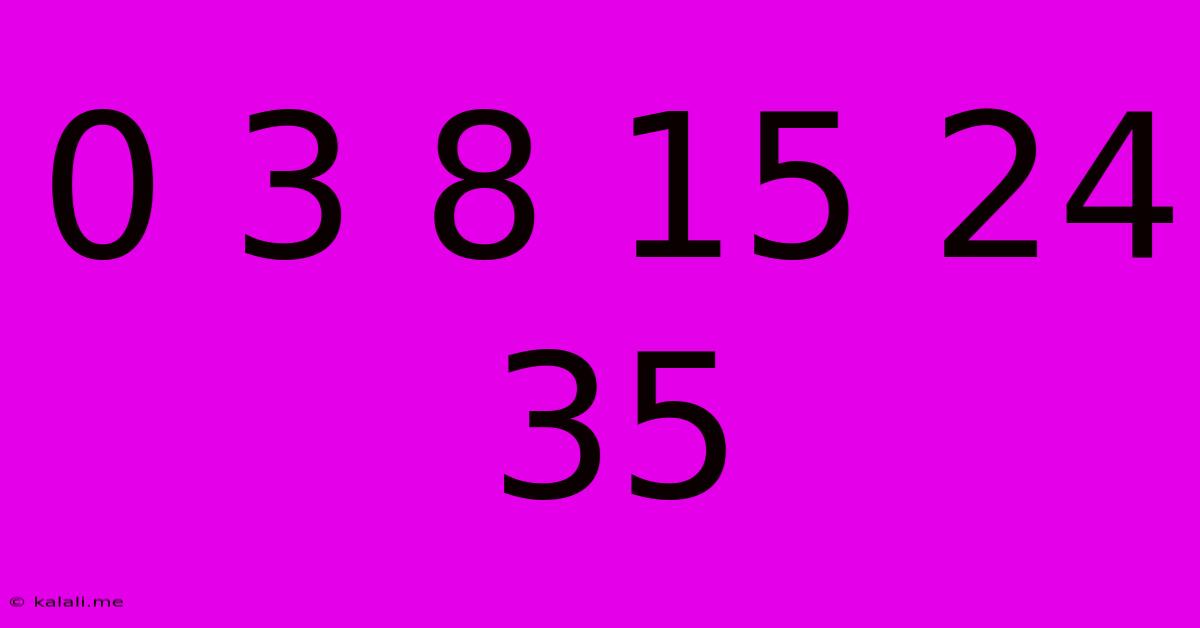0 3 8 15 24 35
Kalali
Jun 09, 2025 · 2 min read

Table of Contents
Decoding the Sequence: 0, 3, 8, 15, 24, 35... Uncovering the Pattern and its Applications
This article delves into the intriguing number sequence: 0, 3, 8, 15, 24, 35... We'll uncover the underlying pattern, explore its mathematical properties, and discuss potential applications. Understanding this sequence provides valuable insights into mathematical reasoning and pattern recognition, crucial skills in various fields including programming, data analysis, and cryptography.
What's the Pattern?
At first glance, this sequence might seem random. However, a closer look reveals a clear and elegant pattern. Notice the differences between consecutive numbers:
- 3 - 0 = 3
- 8 - 3 = 5
- 15 - 8 = 7
- 24 - 15 = 9
- 35 - 24 = 11
The differences themselves form an arithmetic sequence: 3, 5, 7, 9, 11... This is a sequence of odd numbers. This observation allows us to easily predict the next numbers in the original sequence. The next difference would be 13, leading to the next number being 35 + 13 = 48. Following that, the difference would be 15, resulting in 48 + 15 = 63, and so on.
The Formula: Unveiling the Mathematical Representation
We can express this sequence using a mathematical formula. Observing the pattern, we can derive a formula based on the square numbers:
- 0 = 1² - 1
- 3 = 2² - 1
- 8 = 3² - 1
- 15 = 4² - 1
- 24 = 5² - 1
- 35 = 6² - 1
Therefore, the general formula for the nth term in the sequence is: n² - 1 where 'n' represents the position of the number in the sequence (starting with n=1 for the first number).
Applications and Further Explorations
This seemingly simple sequence has surprising applications:
- Programming: The formula can be easily implemented in any programming language to generate the sequence or find a specific term. This is useful in generating test data or solving programming puzzles.
- Data Analysis: Recognizing patterns like this is crucial in data analysis. This sequence could represent a simplified model for trends or data growth in certain scenarios.
- Mathematical Puzzles and Games: This sequence can be used as the basis for various mathematical puzzles and brain teasers, fostering problem-solving skills.
- Education: Understanding this sequence helps develop critical thinking and pattern recognition skills, fundamental in mathematics education.
Beyond the Basics: Exploring Extensions and Variations
The principles behind this sequence can be extended and modified to create variations. For instance, we could explore sequences where the differences form different arithmetic or geometric progressions. This opens up a world of possibilities for further mathematical exploration and problem-solving.
In conclusion, the seemingly simple sequence 0, 3, 8, 15, 24, 35... reveals a rich underlying structure that illustrates the beauty and power of mathematical patterns. Understanding this sequence and its underlying formula provides a valuable foundation for various applications and further mathematical explorations, highlighting the importance of pattern recognition and analytical thinking.
Latest Posts
Latest Posts
-
What Did The Boy Tree Say To The Girl Tree
Jul 01, 2025
-
What Is Martin Luther Kings Favorite Color
Jul 01, 2025
-
How Many Ml In Half A Gallon
Jul 01, 2025
-
What Was Martin Luther Kings Favorite Color
Jul 01, 2025
-
How Many Cups Of Pasta In A Pound
Jul 01, 2025
Related Post
Thank you for visiting our website which covers about 0 3 8 15 24 35 . We hope the information provided has been useful to you. Feel free to contact us if you have any questions or need further assistance. See you next time and don't miss to bookmark.